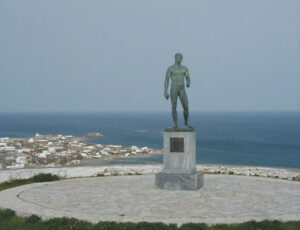Skyros Geographical & Historical Outline
Skyros is the largest island in the Sporades with an area of 209 square kilometers and 130 kilometers of coastline.
It lies removed from the others to the south-east of the group, to the east of the coast of central Evia, opposite the beach of Kymi with which is connected by ferry.
It is a long island with a heavily indented coast, with many small bays and inlets.
At roughly the middle of the island it narrows, as though dividing the island in two, the northern part being rich in vegetation with dense pine woods and bushes, while the south is barren and mountainous.
The highest peak is Kochylas (814 meters).
Administratively, it belongs to the prefecture of Evia.
Skyros Geographical & Historical Outline
HISTORY
Skyros was inhabited as early as the Neolithic period and, according the mythology, was the place where the Athenian king Theseus died and was buried.
According to another legend, it was here, too, at the court of King Lykomedes, that the goddess Thetis hid her son Achilles, disguised as a girl, to prevent him form going to flight in the Trojan War.
The earliest inhabitants of the island were Karians, Pelasgians, and Dolopians, who lived by piracy.
Later, the island was colonized by the Cretans and was then conquered by the Athenians under their general Kimon (468 BC), who settled Athenian colonists here.
It then came under Macedonian control after which it reverted to the Athenians.
During Byzantine times it felt into obscurity, because of piratical raids and was used as a place of exile.
It was captured by the Venetians during the Frankish period, plundered by Hairedin Barbarossa and finally became subject to the Turks.
It was liberated along with the other islands after the Greek War of Independence of 1821.
The island was liberated in 1830.

